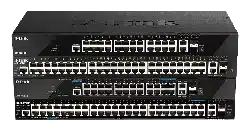Loading ...
Loading ...
Loading ...

DGS-1520 Series Gigabit Ethernet Smart Managed Switch Web UI Reference Guide
344
Port Scheduler Method
This window is used to display and configure the port scheduler method settings.
To view the following window, click QoS > Basic Settings > Port Scheduler Method, as shown below:
Figure 7-2 Port Scheduler Method Window
The fields that can be configured are described below:
Parameter Description
Unit
Select the Switch unit that will be used for this configuration here.
From Port - To Port
Select the range of ports that will be used for this configuration here.
Scheduler Method
Select the scheduler method that will be applied to the specified port(s). Options to
choose from are:
• SP (Strict Priority) - Specifies that all queues use strict priority scheduling. It
provides strict priority access to the queues from the highest CoS queue to
the lowest.
• RR (Round-Robin) - Specifies that all queues use round-robin scheduling. It
provides fair access to service a single packet at each queue before moving
on to the next one.
• WRR (Weighted Round-Robin) - Operates by transmitting permitted packets
into the transmit queue in a round robin order. Initially, each queue sets its
weight to a configurable weighting. Every time a packet from a higher
priority CoS queue is sent, the corresponding weight is subtracted by 1 and
the packet in the next lower CoS queue will be serviced. When the weight of
a CoS queue reaches zero, the queue will not be serviced until its weight is
replenished. When weights of all CoS queues reach 0, the weights get
replenished at a time.
• WDRR (Weighted Deficit Round-Robin) - Operates by serving an
accumulated set of backlogged credits in the transmit queue in a round
robin order. Initially, each queue sets its credit counter to a configurable
quantum value. Every time a packet from a CoS queue is sent, the size of
the packet is subtracted from the corresponding credit counter and the
service right is turned over to the next lower CoS queue. When the credit
counter drops below 0, the queue is no longer serviced until its credits are
replenished. When the credit counters of all CoS queues reaches 0, the
credit counters will be replenished at that time. All packets are serviced until
their credit counter is zero or negative and the last packet is transmitted
completely. When this condition happens, the credits are replenished. When
the credits are replenished, a quantum of credits are added to each CoS
Loading ...
Loading ...
Loading ...
